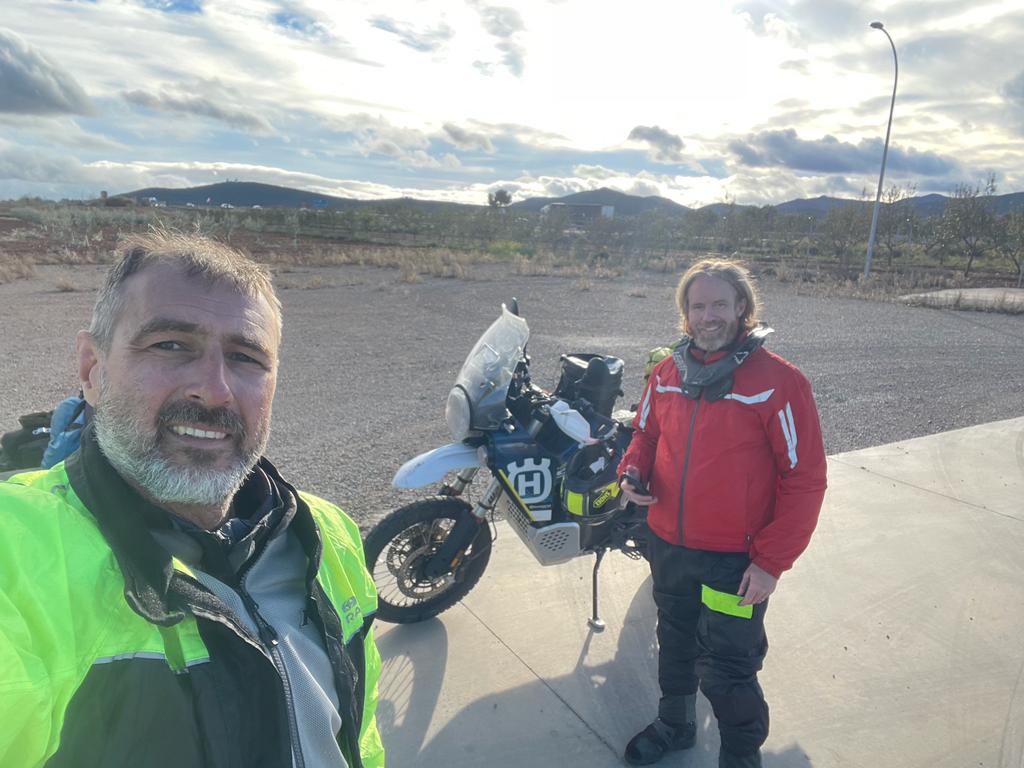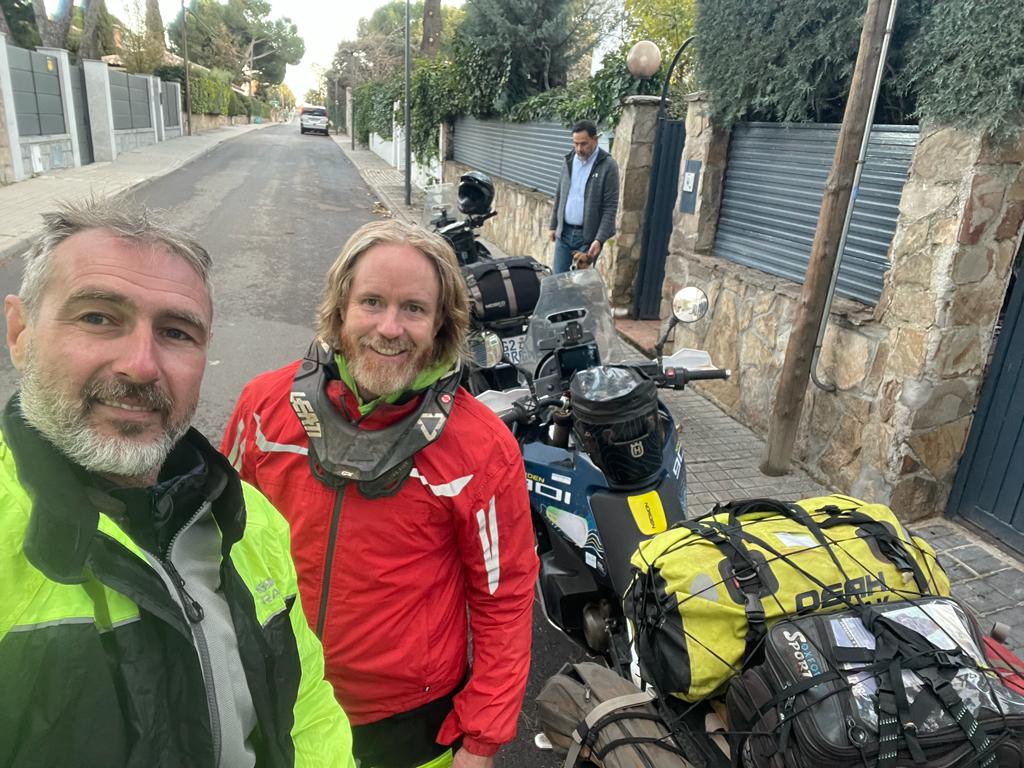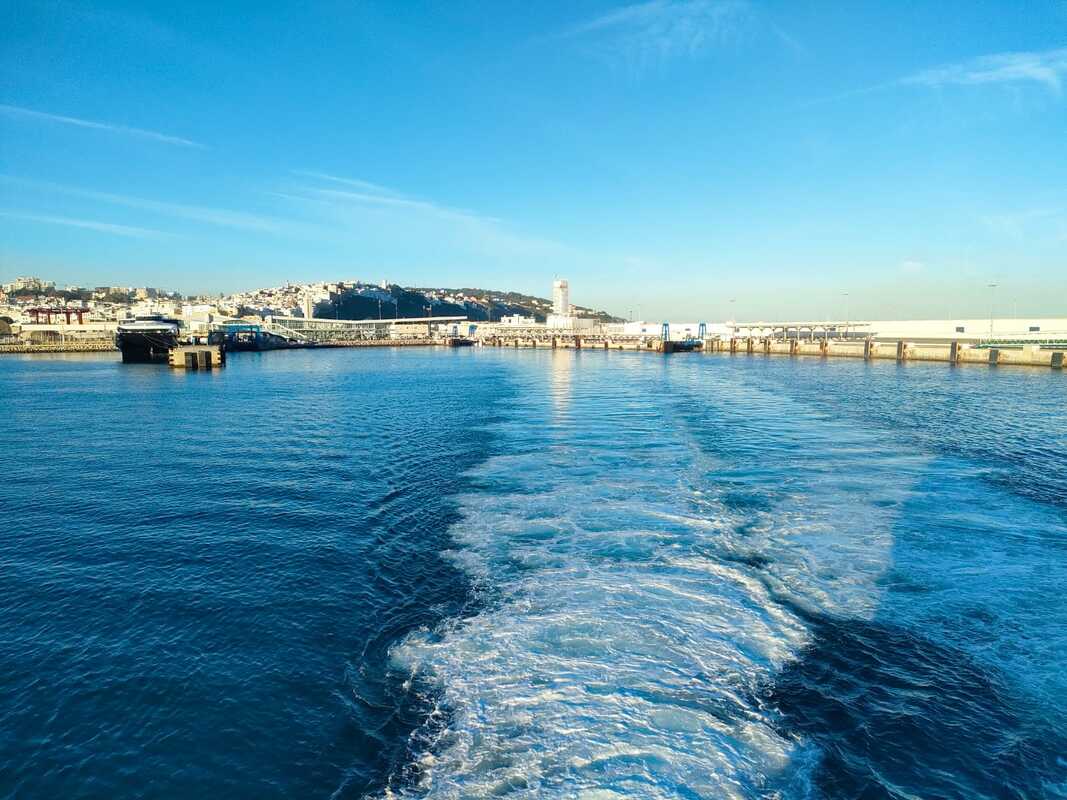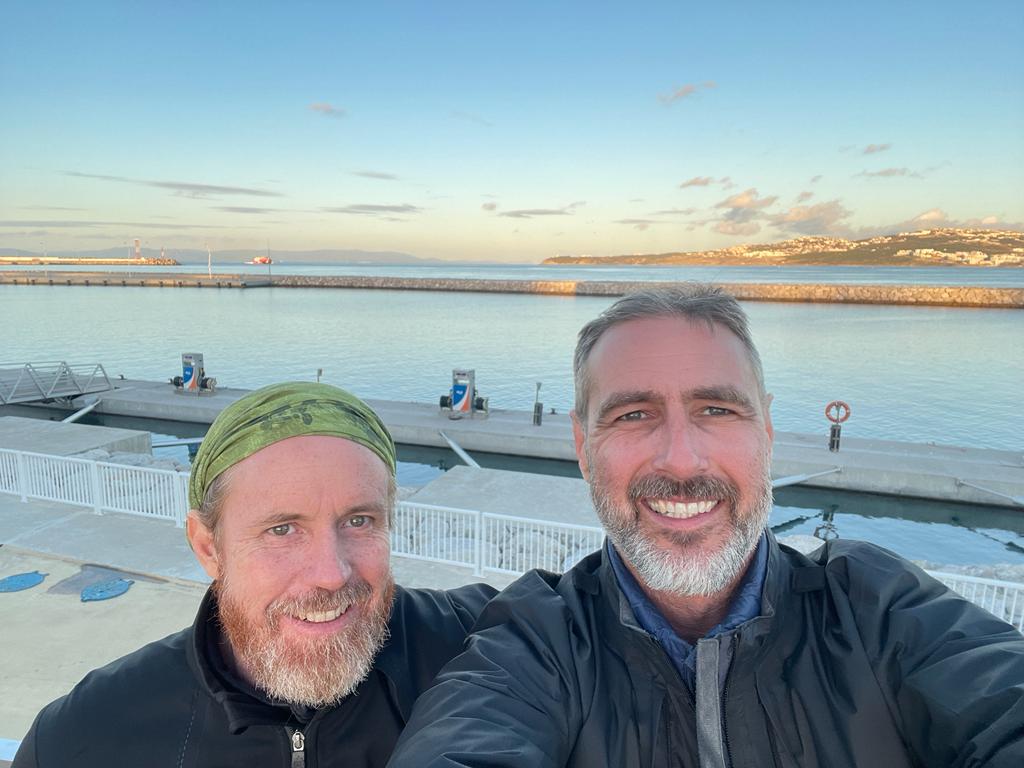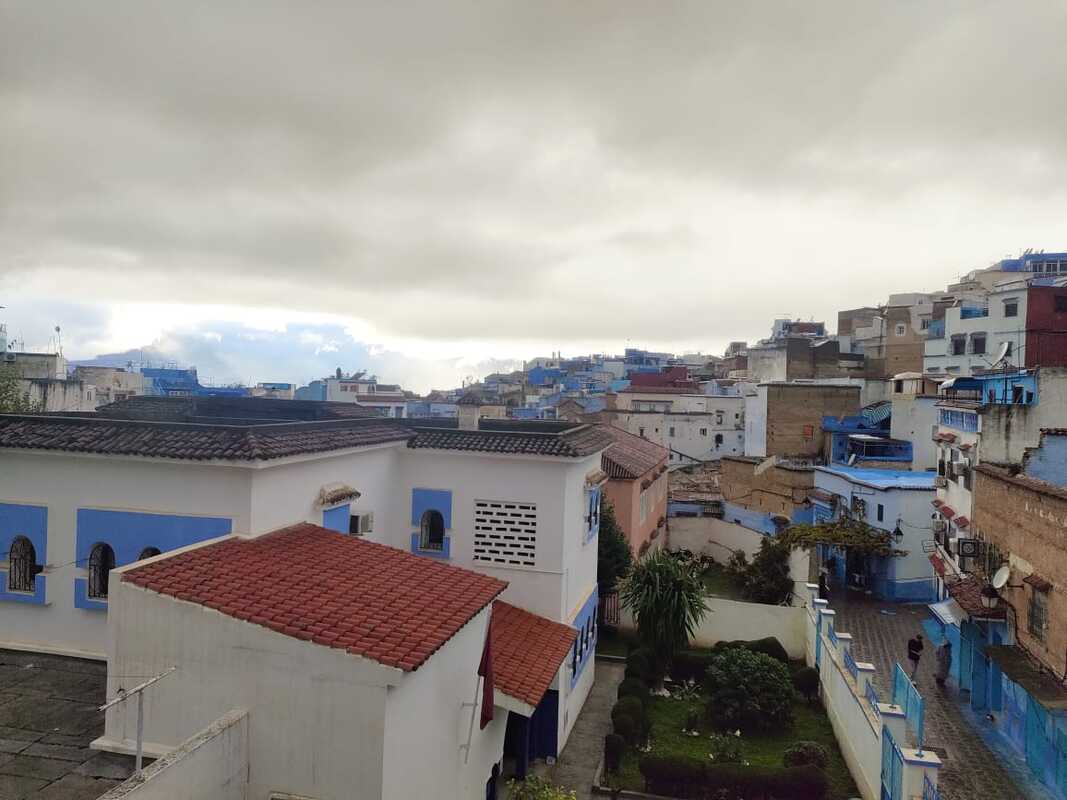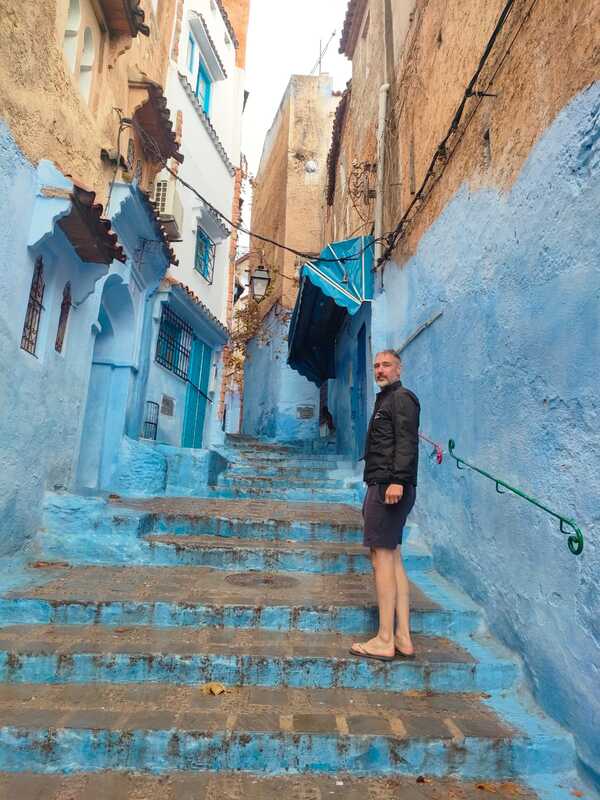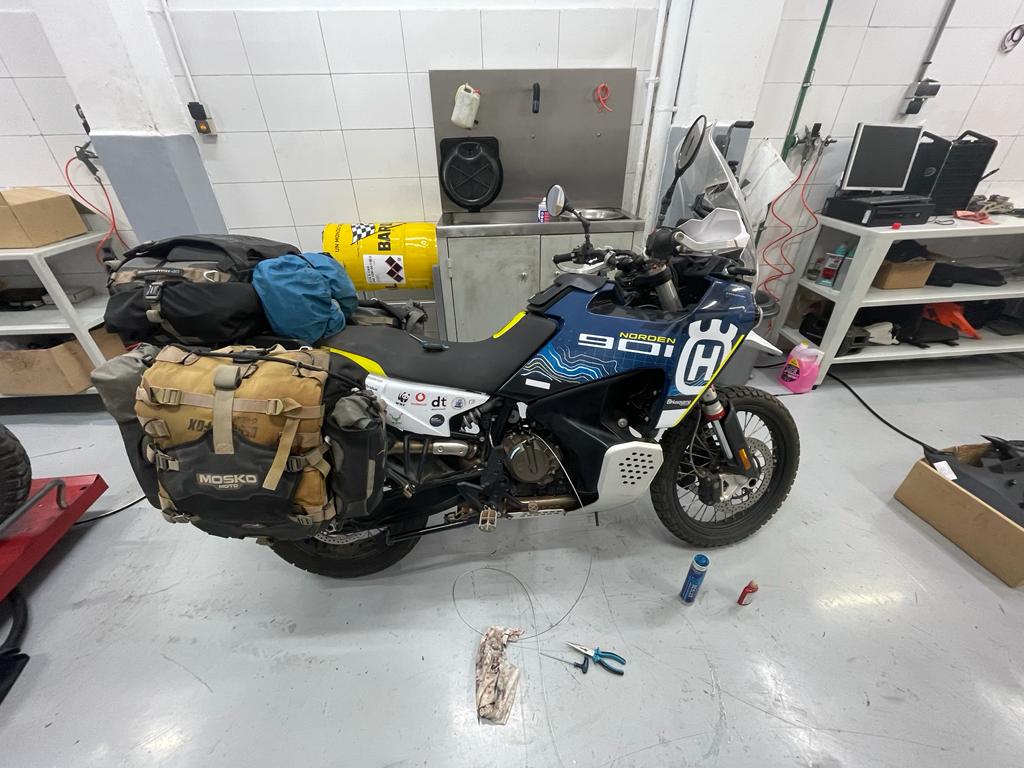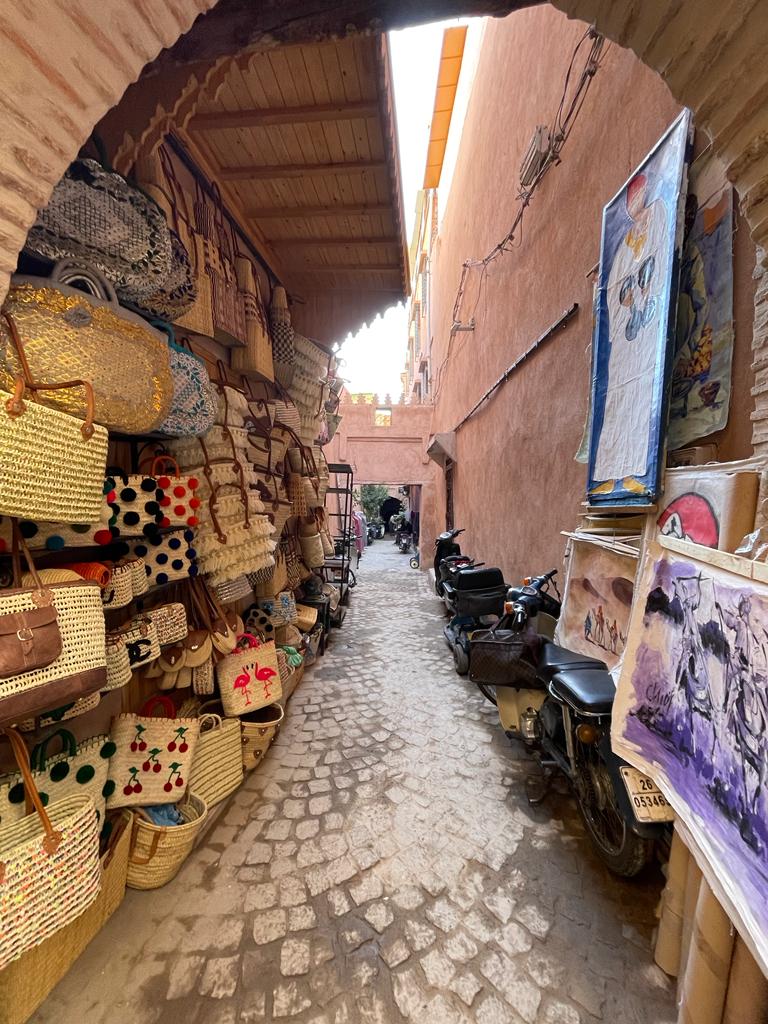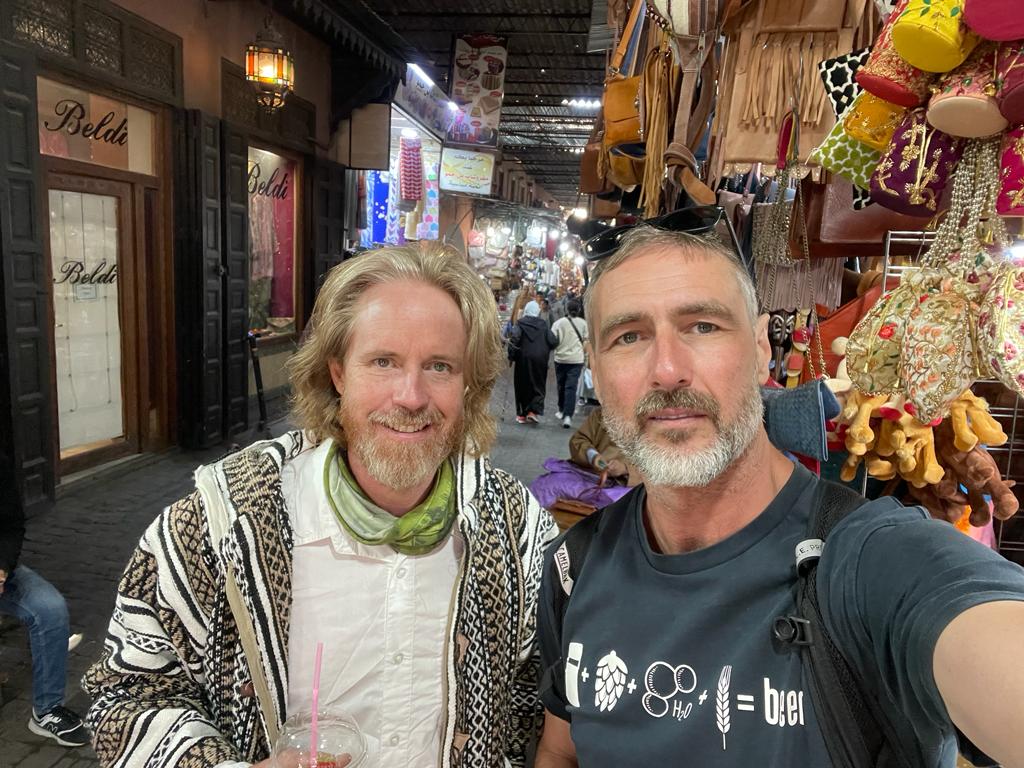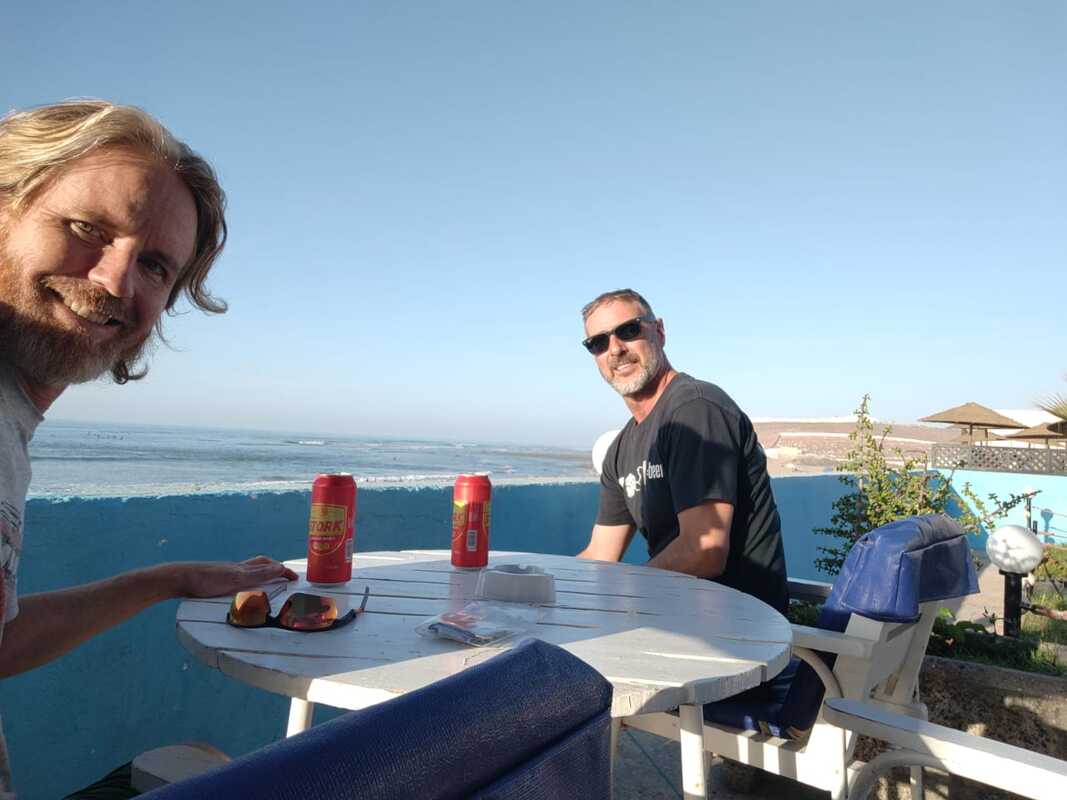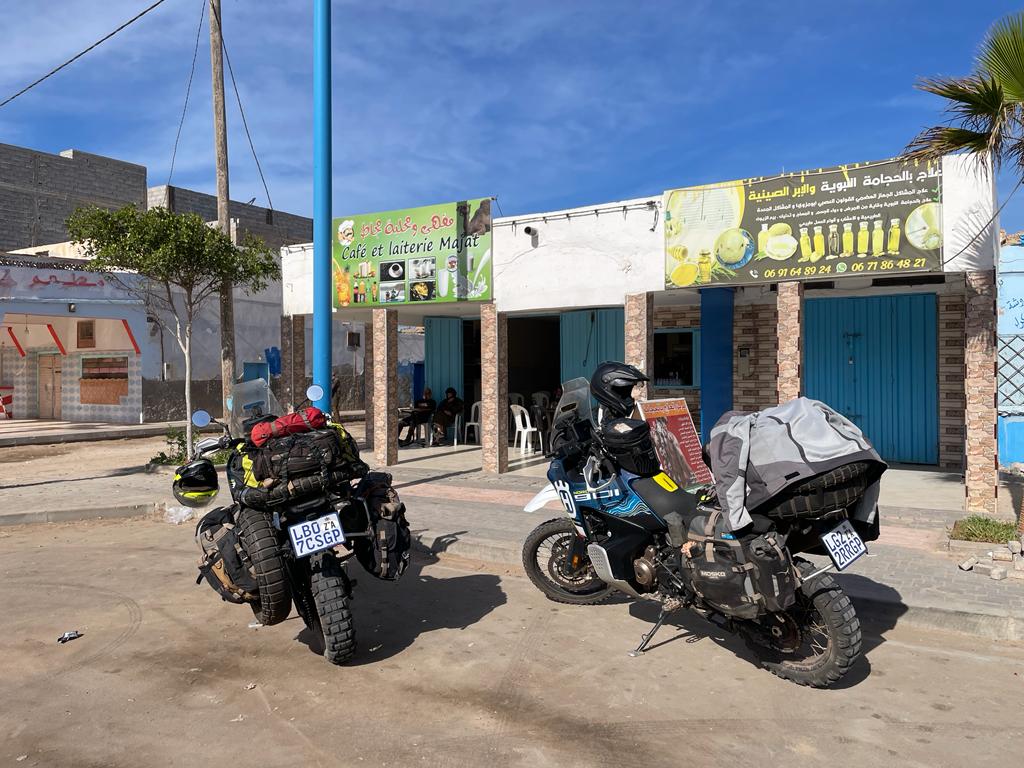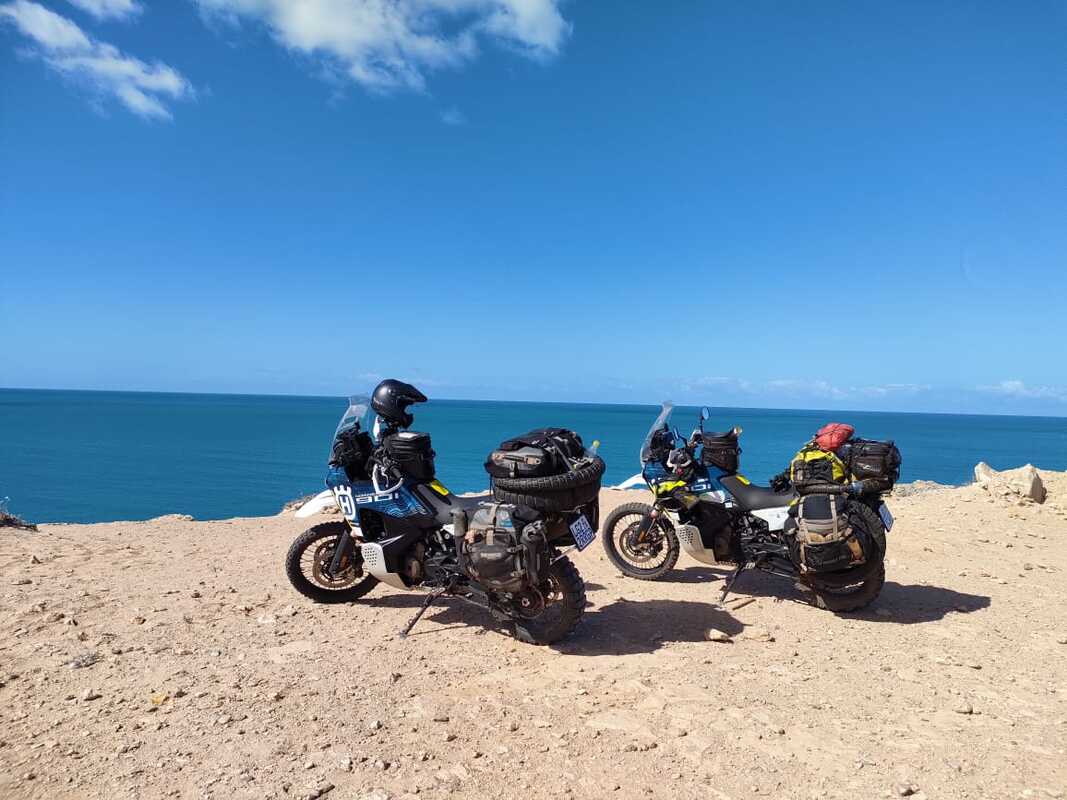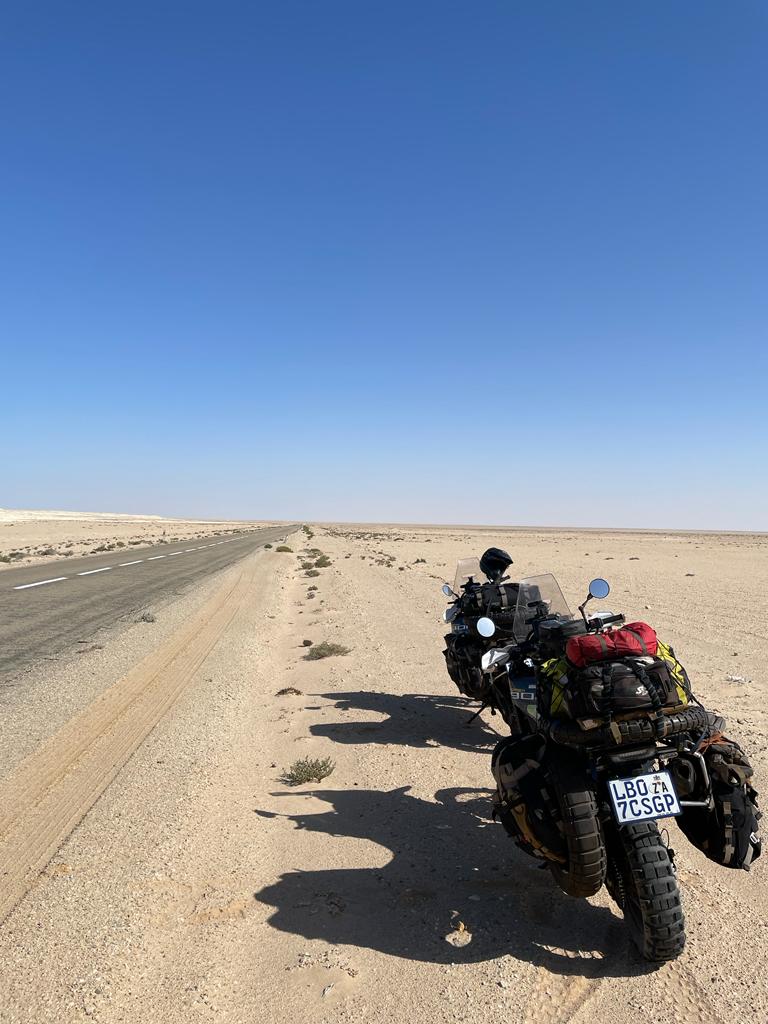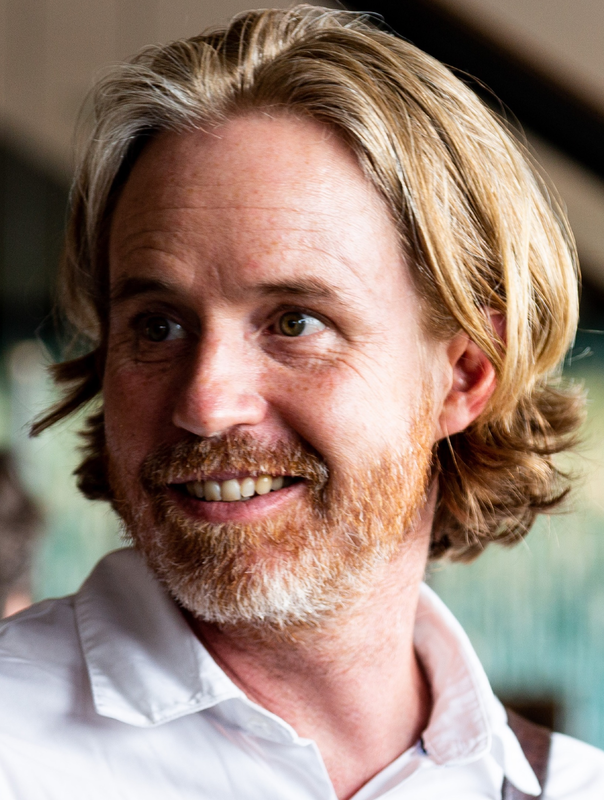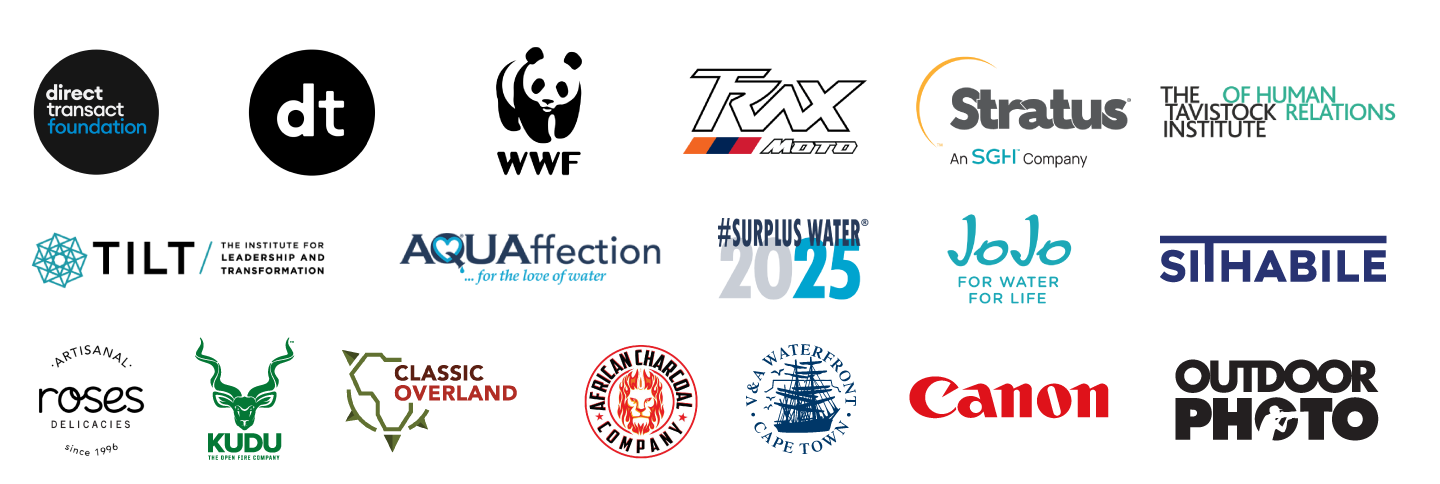|
(English Translation Below)
Dag 80: Seville na Madrid (Die einde...) Dit reën. En dis koud. Ons het 530km om te ry Madrid toe. Die laaste dag van ons toer gaan nie maklik wees nie. Ons motorfietsklere is gemaak vir Afrika-somer en ewenaarshitte, nie vir die Europese winter nie. Ons trek elkeen vyf lae klere aan: T-hemp, dun dons-baadjie, motorfietsbaadjie, nog 'n dun wind-afkeer tipe baadjie, reenjas. Reënbroeke hierdie keer ook van die begin af aan. Ons eet die laaste ontbyt van ons toer. Stop by die winkel om die nuwe interkomstelletjie te kry. Dan ry ons. Eers die eeue-oue klippaadjies wat seepglad deur die ou stad kronkel. Dan die oggendverkeer. En dan uiteindelik die oop pad Noord. Madrid toe. Die temperatuurlesing sê dis 9 grade Celcius. En dit réén. Vandag is dit mind over matter. Daar is geen manier om teen 100km/h, in die nat koue, met ons klere aan, nié te bibber nie. Die geheim is om nie teen die koue te veg nie. Nie eers daaraan te dink nie. Te let op die pad. Mens se eie gedagtes te dink soos altyd. Vir jouself te sing in jou valhelm. Ons stop ná twee ure se vasbyt. Lywe styf. Tone dood. Hande blou. Die garage waar ons gestop het, het nie koffie nie. Ook nie 'n warm, droë binneruimte waar mens kan ontdooi nie. Aan die oorkant staan 'n leë hotel. Ons gaan sit op die trappies onder die afdak. Dis duidelik dat hierdie 'n skuilplek vir randfigure is. Ons eet sjokolade en drink koeldrank. Dan ry ons verder. Word weer een met die koue. Onthou grepe uit ons reis. Word bewus van 'n stemmetjie wat fluister: Ry nóg Noord. Ry deur die hele Europa. Die hele wêreld. Maar eindes is goed. Anders sal beginne sinloos wees. Madrid se snelweë en oor-weë swenk ons heen en weer tot in die buurt waar Martin vir ons wag. Martin is 'n kollega van Fransie en werk by die Suid-Afrikaanse ambassade hier. Sy hond Spotty is glad nie beïndruk met die twee druppende motorfietsryers hier op sy jaart nie. Ons reis is verby. Sonder musiek en balonne en skares en 'n lint. Slegs die onthou van plekke wat ons nooit weer gaan sien nie. Mense wat ons deurgehelp het. Ons parkeer die motorfietse. Haal ons sakke af. Tagtig dae en 18200km agter ons. 'n Miljoen gewaarwordinge binne ons. Die res van ons reis voor ons. Dan stap ons die trappies op. Trap-trap met ons stewels om die ergste water af te skud. Spotty gaan beserk. Hierdie twee randfigure is te veel vir hom. Day 80: Seville to Madrid (The end...) It's raining. And it's cold. We have 530km to ride to Madrid. The last day of our tour won't be easy. Our motorcycle gear is made for the African summer and equatorial heat, not for winter in Europe. We layer up: T-shirt, thin down jacket, motorcycle jacket, another thin wind-resistant jacket, raincoat. Rain pants from the start this time. We have our last breakfast of the tour. Stop at the store to pick up the new intercom unit. Then we ride. First, the centuries-old cobblestone path winding its slippery way through the old city. Then the morning traffic. And finally, the open road North. To Madrid. The temperature reading says it's 9 degrees Celsius. And it's raining. Today is about mind over matter. There's no way to ride at 100km/h, in the wet cold, with these clothes on, without shivering. The secret is not to fight the cold. Not even to think about it. Pay attention to the road. Think your own thoughts. Sing to yourself in your helmet. We stop after two hours of hanging in there. Bodies stiff. Toes numb. Hands blue. The garage where we stopped doesn't have coffee. Also not a warm, dry indoor space to defrost. Next to the garage is an empty hotel. We sit on the steps under the awning. It's clear that this is a shelter for the fringe figures of society. We eat chocolate and drink soda. Then we ride on. Become one with the cold again. Recall snippets from our journey. Become aware of a little voice whispering: Ride further North. Ride through all of Europe. The entire world. But endings are good. Otherwise, beginnings would be meaningless. Madrid's highways and overpasses swerve us to and fro towards the neighbourhood where Martin awaits us. Martin is a colleague of Fransie who works at the South African embassy here. His dog Spotty is not impressed with the two dripping motorcyclists on his turf. Our journey is over. No music, balloons, crowds, or ribbon. Only the memories of places we'll never see again. People who have helped us along. We park the motorcycles. Take off our bags. Eighty days and 18,200km behind us. A million realisations within us. The rest of our journey ahead of us. Then we climb the stairs. Stomp with our boots to shake off the worst of the water. Spotty goes berserk. These two fringe figures are too much for him.
2 Comments
(English Translation Below)
Dag 79: Tangier na Seville, Spanje Die veerboot staan gereed. Ons wag saam met ses of sewe karre om aanboord te gaan. Die dag breek in rooi en oranje hier rondom ons. Dan beduie 'n man met 'n heldergeel weerkaatsende oorpak dat ons kan kom. Die staal oprit is gereed. Ons wiele verlaat Afrika en neem ons die buik van die veerboot binne. Manne staan reg om vas te bind. Beduie ons kan ontspan, koffie gaan kry bo in die boot - hulle hande is veilig. Dis 'n vreemde ervaring om Afrika en Europa so naby aan mekaar te sien. Die Straat van Gibraltar is maar 13km breed. Die ou kontinent en die donker kontinent. Geskei deur slegs 'n skraal stukkie see en tog onlosmaaklik aan mekaar verbind. Die son skuif hoër en baai beide stukke aarde nou in goud en oranje. Bevestig dat ons beide hierdie wêrelde binne ons saamdra. Ons het maar slegs 'n dun sliert Afrika met ons eie lywe beleef. Te min om oor te spog, genoeg om te weet hoe min ons weet. Dan ry ons Spanje binne. Die grenspos verloop glad. Ons stop om petrol te kry. Hier's nie petroljoggies soos in Afrika nie. Jy gooi self jou petrol in. Loop dan na die winkeltjie toe om te betaal. Met 'n kaart. Die teerpad Seville toe kronkel eers langs die see, Gibraltar se rigting, en draai dan die binneland in. Die lug is koel maar die son skyn. Perfekte motorfietsweer. Ons kry môre in Seville die Cardo interkomtoestelletjie om myne te vervang wat gebreek het. Dis bietjie mosterd ná die maal, want môre is ons laaste dag as deel van ons formele toer. Daarná kan dit dalk nog handig wees as ons moet Milan of Rotterdam toe ry om die motorfietse se terugvervoer uit te sorteer. Maar sover lyk die kanse goed dat ons die fietse sommer in Madrid verkoop sal kry. Seville is pragtig. Kanovaarders oefen op die rivier. Oumense stap met hulle honde. Fikses op rolskaatse. 'n Spesiale paadjie vir fietse langs die karre-pad. Mense om tafeltjies met wyn en Sondag middagete. Vrouens ook. Sonder kopdoeke. Elke kultuur het sy skadu-kant. Maar elke kultuur het ook baie om op trots te wees. Day 79: Tangier to Seville, Spain The ferry is ready. We wait with six or seven cars to board. The day breaks in red and orange around us. Then a man in a bright yellow reflective suit signals that we can come. The steel ramp is ready. Our wheels leave Africa and take us into the belly of the ferry. Men standing ready to tie down the bikes. They tell us to relax, go get coffee upstairs in the boat - their hands are safe. It's a strange experience to see Africa and Europe so close to each other. The Strait of Gibraltar is only 13km wide. The old continent and the dark continent. Separated by only a narrow stretch of sea and yet inseparably interconnected. The sun rises higher, bathing both pieces of land in gold and orange. Confirming that we carry both these worlds within us. We have only experienced a very thin slither of Africa with our own bodies. Too little to brag about, enough to know how little we know. Then we enter Spain. The border post goes smoothly. We stop to get petrol. There are no petrol attendants like in Africa. You fill your own tank. Then you walk to the little shop to pay. With a card. The asphalt road to Seville winds first along the sea, in the direction of Gibraltar, and then turns inland. The air is cool but the sun shines. Perfect motorcycling weather. Tomorrow in Seville, we'll get the Cardo intercom device to replace mine that broke. It's a bit late in the game since tomorrow is our last day as part of our formal tour. After that, it might still be useful if we have to ride to Milan or Rotterdam to sort out the return transport of the motorcycles. But so far, the chances look good that we'll be able to sell the bikes in Madrid. Seville is beautiful. Canoeists practice on the river. Old people walk their dogs. Fit ones on rollerblades. A special lane for bicycles alongside the car road. People at tables with wine and Sunday lunch. Women too. Without headscarves. Every culture has its shadow side. But every culture also has much to be proud of. (English Translation Below)
Dag 78: Chefchaouen na Tangier Die pas is nog glad van gister se reën. Ons ry op eiers. Wil vandag, van alle dae, nie gly nie. Dis twee ure tot in Tangier, ons laaste stukkie Afrika. Toe die son bietjie hoër sit, en die pad droër is, kan ons die pas se draaie geniet. Dit voel soos die laaste stukkie van 'n waterglybaan wat mens links en regs gooi voordat hy jou in die swembad uitspoeg. Skielik, oor 'n hoogtetjie, sien ons die see. Maar nog meer: ons sien die berge aan die ander kant. Europa en Afrika. Swemafstand van mekaar af. Tarifa wat wit teen die voet van die heuwel sit en wag. Ons parkeer. Stap die strate in. Dis duidelik dat Europa oorgespoel het dié kant toe. De Witt sê as iemand jou oë toemaak en jou hier neersit sal jy dink jy's in Madrid of Parys. Ons neem foto's van die laaste stukkie Afirka en Europa wat in die verte loer. Stuur dit vir ons mense. Hulle oe en a oor die wonder van wat ons vermag het. 17400km deur die kontinent! Maar ons voel nie die grootsheid daarvan nie. Het vandag maar net weer nog 'n kort entjie gery. Soos byna elke dag sedert middel September. Stukkie vir stukkie soos mens 'n olifant eet. Die anti-klimaks bevestig ons ervaring dat dit nie oor 'n wenpaal gegaan het nie, maar oor die reis hierheen. Môre weer 'n grensoorgang. Gaan Spanje tevrede wees met ons versekeringspapiere vir die motorfietse? Of gaan ons verskering in die hawe moet koop? Altyd die opwinding en onsekerheid van grense oorsteek. Van minder mag hê as die amptenary. Day 78: Chefchaouen to Tangier The pass is still slippery from yesterday's rain. We ride cautiously, not wanting to slip today of all days. It's two hours to Tangier, our last piece of Africa. As the sun rises a bit higher, and the road dries up, we can enjoy the twists and turns of the pass. It feels like the last part of a water slide, tossing you left and right before spitting you into the pool. Suddenly, rising over a hill, we see the sea. But even more: we see the mountains on the other side. Europe and Africa. Within swimming distance of each other. Tarifa sitting white against the foot of a hill, waiting. We park. Walk the streets. It's clear that Europe has overflowed this way. De Witt says if someone were to close your eyes and drop you off here, you'd think you were in Madrid or in Paris. We take photos of the last piece of Africa and Europe peeking in the distance. Send it to our people. They reply in awe of what we've accomplished. 17,400km through the continent! But we don't feel the grandeur of it. Today we rode just another short stretch. Like almost every day since mid-September. Piece by piece, like eating an elephant. The anti-climax confirms our experience that it wasn't about reaching a destination, but about the journey itself. Tomorrow, another border crossing. Will Spain be satisfied with our insurance papers for the motorcycles? Or will we have to buy insurance at the port? Always the excitement and uncertainty of crossing borders. Of having less power than the officials. (English Translation Below)
Dag 77: Rabat na Chefchaouen Die laaste 120km is kronkelpad deur plaasdorpies. Die landskap groen. Bloekombome langs die pad. Vrugteboorde. Skape. Trekkers. Geen slaggate. Skielik die Rif-berge. Bergpasse. Dan reën dit. Die eerste reën van die seisoen. Eers drup-drup. Dan effens harder. Ons stop. Trek ons reënbaadjies aan. Nie nou lus vir die gesukkel om die reënbroeke aan te trek nie. Dink dit gaan oorwaai. Hoe hard kán dit nou reën hier Noord van die Sahara? Maar die bergpasse word styler en die reën harder. Dis moeilik om te sien. Die pad is soos 'n koekie seep van maande se olie- en diesel-lekke. Ons lywe later deurdrenk en styf-koud. Skielik 'n blinde draai. Kar reg van voor af aan ons kant van die pad. Hy gaan 'n vragmotor verby maar gaan dit nie maak nie. De Witt moet op 'n haarbreedte lyntjie teerpad tussen die kar en die afgrond deurkorrel. Later, in 'n dorpie, stop 'n taxi dood reg voor De Witt. Die fiets se remme gryp-gryp-gryp en die voorwiel druk sy swart patroontjie netjies op die taxi se wit buffer af. Die ou klim uit, sien dis niks, waai vir ons. Buite die dorpie vind ons 'n afdak. Reg langs 'n koffie-plekkie. Ontdooi 'n bietjie. Dan die laaste entjie Chefchaouen toe. Die berg vou voor ons oop en ons sien die dorpie ingebed teen die hang. Blou en wit geboutjies. Ons parkeer buite die medina. Druipnat. Dra ons sakke skeef-skeef die doolhof van stegies binne. Die eeue-oue trappies uit. Die een smous na die ander hier reg teenaan ons: soek julle dagga? Verstaan nie 'nee' nie. Blykbaar is daar in hierdie geweste ook ou Romeinse ruïnes te siene. Bewyse dat beskawings kom en gaan. Hier in Marokko, waar die toeriste-kultuur die ou dele tot smousplekke van nonsens vervlak het, voel mens deel van die verval. Word daar iets in mens wakker wat hunker na wat eg is, wetende dat ons net so selfsugtig saamspeel in die erosie van gerief en ontvlugting. Nog een dag tot in Tangier. Dan die veerboot Europa toe. Day 77: Rabat to Chefchaouen The last 120km winds through farming villages. The landscape green. Blue gum trees line the road. Orchards. Sheep. Tractors. No potholes. Suddenly, the Rif Mountains. Mountain passes. Then it rains! The first rain of the season. At first, it's just a drizzle. Then a bit harder. We stop. Put on our rain jackets. Not in the mood for the hassle of putting on rain pants now. Think it will pass. How hard can it rain here north of the Sahara anyway? But the mountain passes get steeper, and the rain harder. It's difficult to see. The road slippery from months of oil and diesel leaks. Our bodies later drenched and stiff-cold. Suddenly a blind turn. Car coming right at us on our side of the road. It's overtaking a truck but it won't make it. De Witt has to aim through a hairline line of asphalt between the car and the cliff. Later, in a village, a taxi stops right in front of De Witt. The bike's brakes grab-grab-grab, and the front wheel neatly presses its black pattern onto the taxi's white bumper. The guy gets out, sees it's nothing, waves to us. Outside the village, we find a shelter. Right next to a coffee place. Warm up a bit. Then the last stretch to Chefchaouen. The mountain unfolds before us, and we see the village nestled against the slope. Blue and white buildings. We park outside the medina. Soaking wet. Carry our bags through the maze of alleys. Up the centuries-old stairs. One peddler after another right here next to us: Do you want some weed? Doesn't understand 'no.' Apparently, in these parts, there are also ancient Roman ruins. Evidence that civilizations come and go. Here in Morocco, where tourist culture has turned the ancient medinas into superficial souvenir stalls selling nonsense, one feels part of the decay. Something inside us yearns for what is genuine. Knowing that we also, just as selfishly, play along in the erosion of comfort and escape. One more day to Tangier. Then the ferry to Europe. (English Translation Below)
Dag 76: Marrakech na Rabat Ons wikkel onsself stadig los uit die oggendverkeer oppad snelweg toe. Kom by 'n sirkel. Ek is op De Witt se hakke. Reg om oop te maak sodra hy 'n gaping vat. Skielik 'n halwe gaping. Ek gee vet. Maar die kar kóm en De Witt rém. Ek gaan hom tref! Swenk regs, rem hárd. Mis vir De Witt, maar die skielike rem en uitswaai en momentum is te veel en ek beland op die teer. Karre wat stop en uitswaai en vir De Witt beduie sy makker is plat. Ek spring op en beur die fiets regop. Dan is De Witt by en gee die laaste hupstoot. Ons is op en ry weer. Adrenalien. Het ek nie in vanoggend se blog geskryf ons moet nou net nie in die pylvak struikel nie? Die ritme van die langpad laat my adrenalien bedaar. Ons stop na 'n uur of wat vir petrol en 'n koeldrank. De Witt kyk bekommerd na sy koppellaar-hefboom. Die kabel is besig om los te torring! As hy af is, staan ons. Ons weet daar's 'n KTM handelaar in Casablanca, só 120km verder. Reken as De witt sy fiets se quickshifter aktiveer, en dus slegs die koppellaar hoef te gebruik vir wegtrek in eersterat, kan die kabel dalk hou tot daar. Ons ry. Die tolhekke, en later die verkeer in Casablanca, toon geen genade nie. Forseer ons telkens tot stilstand. Dan moet De Witt se koppellaar-kabel aan sy laaste vesels beur om weg te trek, te stop, weg te trek, te stop. Uiteindelik die wonderlike oranje letters: KTM! Ons kom gelyk saam met 'n Engelsman op 'n Husqvarna 701 daar aan. Moet vir drie fietse op die Europees-geïnspireerde smal en tjok-en-blok geparkeerde sypaadjie parkeerplek vind. Ek moet inskuif tussen 'n beton-blombak en die oprit na die winkel langsaan. Die blombak druk teen my bagasie-sak aan die linkerkant. Ek probeer aan die regterkant afklim sodat die blombak nie omval nie. Verloor balans. Val met fiets en al oor na regs die straat in. Voel iets teen my voet. Wil hom wegtrek maar hy sit vas. Kyk om. 'n Kar het net-net betyds gestop vir die petalje, met sy voorwiel half op die hak van my stewel. Ek draai my voet los en trek hom uit. Die kar ry. Dit was amper! Dis eenuur. Die winkel maak op Vrydae van eenuur tot drie-uur toe vir middagete. Ons gaan eet middagete saam met Engelsman. Hy is getroud met 'n Marokkaanse vrou. Kuier vir 'n paar dae by haar familie in Casablanca. Ons gesels motorfietsry. Toe die klok drie-uur slaan is ons terug by die winkel. 'n Halfuur later is die nuwe kabel in, plus hulle gee ons 'n spaar-kabel saam vir ingeval myne volgende groet. Als sonder om 'n sent te vra! Hulle wens ons alle voorspoed toe en beduie ons die beste pad stad uit in Rabat se rigting. Ons kom net voor donker by ons blyplek aan. 'n Gesin in die ou medina verhuur kamers in hulle huis uit op Airbnb. 'n Outentieke Marokkaanse ervaring! Ons ontmoet 'n jong Italiaanse paartjie daar wat videos van hulle reise op Youtube plaas vir 'n lewe. Gaan eet saam met hulle. Gesels oor reis en hoe dinge wat foutgaan telkens geleenthede skep vir ontmoetings met die warmte van mense. Afrika het weer haar hand oor ons gehou vandag. Iets van haarself aan ons geopenbaar. Ons is nog op reis. Day 76: Marrakech to Rabat We slowly disentangle ourselves from the morning traffic on our way to the highway. Approach a roundabout. I'm on De Witt's heels, ready to open up as soon as he finds a gap. Suddenly, a half-gap. I give it throttle. But the car keeps coming and De Witt hits the brakes. I'm going to hit him! I swerve right, brake hard. Miss De Witt, but the sudden braking, swerving, and momentum are too much, and I end up on the asphalt. Cars stop and swerve, indicating to De Witt that his buddy is down. I jump up. Start lifting the bike. Then De Witt is there to give the final push. We're up and riding again. Adrenaline. Didn't I write in this morning's blog that we now just shouldn't stumble in the home straight? The rhythm of the long road calms my adrenaline. We stop after an hour or so for petrol and a cold drink. De Witt looks at his clutch lever. Concerned. The cable is starting to fray! If it breaks, we're stuck. We know there's a KTM dealer in Casablanca, about 120km further. We figure that if De Witt activates his bike's quick-shifter, using the clutch lever only for first gear, the cable might hold until then. We ride. The toll gates, and later the traffic in Casablanca, show no mercy. Force us to stop repeatedly. The clutch cable holding on for dear life. Finally, the wonderful orange letters: KTM! We arrive simultaneously with an Englishman on a Husqvarna 701. Have to find parking for three bikes on the European-inspired narrow and jam-packed sidewalk. I have to squeeze in between a concrete flower pot and the entrance to the shop next door. The flower pot presses against my left saddle bag. I try to dismount on the right hand side so that the flower pot doesn't tip over. Lose balance. Fall with the bike into the street to the right. Feel something against my foot. Want to pull it away, but it's stuck. Look around. A car has stopped just in time. Its front wheel half on the heel of my boot. I twist my foot loose and pull it out. The car drives off. It was close! It's one o'clock. The shop closes from one to three for lunch. We go out for lunch with the Englishman. Ian. He's married to a Moroccan woman. Visiting her family in Casablanca for a few days. We talk about motorcycling. When the clock strikes three, we're back at the shop. Half an hour later, the new cable is in, and they give us a spare one in case mine breaks next. All this without asking for a cent! They wish us all the best and show us to the best way out towards of the city towards Rabat. We arrive just before dark at our accommodation. A family in the old medina rents out rooms in their house through Airbnb. An authentic Moroccan experience! We meet a young Italian couple there who post videos of their travels on YouTube for a living. Go eat with them. Talk about travel and how things that go wrong create opportunities to encounter the warmth of people. Africa has once again held her hand over us today. Revealed something of herself. We're still on our journey. (English Translation Below)
Dag 74 en 75: Agadir na Marrakech Snelweg! Ons het voor die toer laas 120km/h gery. Twee perde wat stal ruik. Die pad kronkel deur die Atlasberge, duik deur 'n tonnel, en dan, aan die Noordekant, tref die koue lug ons. Europa is naby, maar daar is nog vier dae se ry oor. Ons moet kophou. Wil nie in die pylvak struikel nie. In Marrakech bly ons 'n dag oor sodat ons die antieke dorp kan besoek. 'n Gevoel kan kry van 'n ander wêreld in 'n vorige era. Ons het ook logistieke reelings om te tref. Dit begin al hoe meer lyk asof ons plan om die motorfietse vanaf Rotterdam te verskeep, nie vir ons gaan werk nie. Té duur, té veel maande, die Suid-Afrikaanse hawens té oorvol. Ons begin pryse te kry om die motorfietse terug te vlieg. Dis duurder maar die proses lyk skoner en natuurlik vinniger. Dan kom die boodskap vanuit Madrid: Die Husqvarna handelaar daar sal die motorfietse koop, maar wil net sekermaak oor die papierwerk om dit wettig uit- en in te voer. Dis 'n gerondbellery tussen Trax Moto Pretoria, Husqvarna Suid-Afrika, Husqvarna Spanje, Motos Arribas Madrid en Husqvarna Hoofkantoor Oostenryk. Niemand het nog ooit twee Husqvarnas vanaf Suid-Afrika stroomop terug uitgevoer Europa toe nie. Dan loop ons na die ou dorp toe. In die Marrakech medina glip mens heen en weer in tyd. Die doolhof van stegies en klipstraatjies is nog soos eeue gelede, maar die plek loop nou oor van toeriste-gemorsies. Dis armbande en serpe en T-hemde en borde en magnete en belde en handsakke en skoene en teekoppies en dolke en horlosies en hoede en musse en baadjies en skilderye en matte. Slange wat dans vir 'n lewe. 'n Apie aan 'n tou wat truuks moet doen. Later wil mens net uit. Ons het die Afrika-gespook om oorlewing weer teruggeruil vir die Westerse web van koop-koop-koop. Terug by ons blyplek sit ons op die balkon en eet kaas en sardientjies en soutkoekies. Drink 'n bier. Kyk vir nuwe nuus oor die motorfietse. Besef ons wil nou net huistoe gaan. Day 74 and 75: Agadir to Marrakech Highway! We haven't ridden at 120km/h since our tour began. Two horses catching a whiff of the stable. The road winds through the Atlas Mountains, dives through a tunnel, and then, on the northern side, the cold air hits us. Europe is close, but there are still four days of riding ahead. We need to keep our wits together. No stumbling in the final stretch! In Marrakech, we stay an extra day to visit the ancient village. To get a sense of a world from a lost era. We also have logistical arrangements to make. It's starting to look more and more like our plan to ship the motorcycles from Rotterdam won't work for us. Too expensive, too many months, the South African ports too congested. We're getting quotes to fly the motorcycles back. It's pricier, but the process looks cleaner and of course faster. Then comes the message from Madrid: The Husqvarna dealer there will buy the motorcycles but wants to make sure about the paperwork for legal export and import. It's a round robin between Trax Moto Pretoria, Husqvarna South Africa, Husqvarna Spain, Motos Arribas Madrid, and Husqvarna Headquarters Austria. No one has ever exported two Husqvarnas from South Africa upstream to Europe. Then we walk to the old village. In the Marrakech medina, one slips back and forth in time. The labyrinth of alleys and cobblestone streets is still like centuries ago, but the place is now overflowing with touristy clutter. Bracelets and scarves and T-shirts and plates and magnets and belts and bags and shoes and teacups and daggers and watches and hats and beanies and jackets and paintings and carpets. Snakes dancing for a living. A monkey on a rope doing tricks. Later, we just want to get out. We traded the African struggle for survival for the Western web of buy-buy-buy. Back at our accommodation, we sit on the balcony and eat cheese and sardines and salty crackers. Have a beer. Check for new news about the motorcycles. Realize we just want to go home now. (English Translation Below)
Dag 73: Sidi Ifni na Agadir Die Afrika-avontuurgedeelte van ons reis is verby. Hier waar ons nou ry kon netsowel in die Kaap gewees het. Die pad kronkel al langs die see soos die pad tussen Bettiesbaai en Gordonsbaai. Dit is koud. Nie koud genoeg vir my dons-baadjie onder my motorfietsbaadjie nie, het ek gedink voor ons weggetrek het. Ek was verkeerd. Ná twee ure van vasbyt in die koue, kry ons 'n koffiewinkel reg uit die hemel, in die goue son toegedraai, net buite Agadir. Café Jana. Ons ontdooi. Drink koffie. Eet 'n tipe pita-deeg pannekoek deurdrenk van stroop. Goud soos die son. Ons mis nou ons mense. Vir die eerste keer voel dit soos vakansie en ons sou dit graag met ons gesinne wou deel. In Agadir kry ons 'n motorfiets-werkswinkel. Haal die rowwe bande af en sit weer ons 50/50 grondpad/teerpad bande terug. Los die rowwes net daar. Vir die eerste keer in meer as 10000km gaan ons nie 'n ekstra stel bande saamkarwei nie. Ons maak ook kettings en lugfilters skoon. Sit nuwe remskoene in. Die fietse voel nuut en lig en reg om nog vér te ry! Dis nog so 1000km tot by Tangier waar ons die veerboot kry Spanje toe. Dan nog byna 3000km deur die Europese winter tot by Rotterdam - ás ons besluit om voort te gaan met die plan om die fietse van daar af te verskeep. Ons het intussen begin rondvra oor die koste om die fietse uit Spanje of Portugal te laat vlieg. Wag nog vir antwoorde. Dit sal duur wees. Maar 3000km se petrol en tolpaaie en oorslaap en eet in Euro's sal ook duur wees. Plus die koue in ons somerklere laat ons nóú al bibber, wat nog van as dit tien grade kouer is. En nat. Ons kry 'n slaapplek 'n entjie buite Agadir langs die see. Dis die speelplek van die Europese branderplankryers. Al wat nog herinner aan die Afrika waardeur ons gery het, is die klein motorfietsies wat sonder valhelms gery word. Hier's 'n duisend keer minder van hulle, en hulle hou min of meer by die padreëls, maar die boodskap bly dieselfde: Geniet die vryheid van Afrika. Wat kan fout gaan? Day 73: Sidi Ifni to Agadir The Africa adventure part of our journey is over. Here where we're riding now could just as well have been in Cape Town. The road winds along the sea like the stretch between Betty's Bay and Gordon's Bay. It's cold. Not cold enough for my puffer jacket under my motorcycle jacket, I thought before we set off. I was wrong. After two hours of grinding our teeth in the cold, we find a coffee shop straight from heaven, wrapped in golden sunlight, just outside Agadir. Café Jana. We defrost. Drink coffee. Eat a type of pita dough pancake soaked in syrup. Gold like the sun. We miss our people now. For the first time, it feels like holiday, and we would have liked to share it with our families. In Agadir, we find a motorcycle workshop. Take off the off-road tires and put back our 50/50 off-road/tarmac tires. Leave the rugged ones right there. For the first time in more than 10,000 km, we won't be carrying an extra set of tires. We also clean the chains and air filters. Put in new brake pads. The bikes feel new and light and ready to ride much further! It's about 1000km to Tangier, where we will take the ferry to Spain. Then almost 3000km through the European winter to Rotterdam – if we decide to continue with the plan to ship the bikes from there. We have in the meanwhile started asking around about the cost of flying the bikes from Spain or Portugal. Still waiting for answers. It will be expensive. But 3000km of petrol, toll fees, accommodation and food, in Euro, will also be expensive. Plus, the cold weather in our summer riding clothes already has us shivering, let alone if it's ten degrees colder. And wet. We find accommodation a bit outside Agadir along the sea. It's the playground of European surfers. All that still reminds us of the Africa we travelled through is the small motorcycles ridden without helmets. There are a thousand times fewer of them here, and they more or less follow the rules, but the message remains the same: Enjoy the freedom of Africa. What could go wrong? (English Translation Below)
Dag 72: Laayoune na Sidi Ifni, Morocco Daar is 'n weggestrooptheid aan die woestyn. 'n Naakte eerlikheid. Fieterjasies en aansit en oortolligheid word weggeskroei deur die son en die wind en die skaarskeid aan water. Mens sien dit aan die landksap. Die dorpies volgens oases gevorm. Die eenvoudige lyne van kubus-huisies in rooi-bruin, grys en wit. Vierkantige venstertjies. Rame en deure almal dieselfde koningsblou. Ons is koud en styf gery ná twee ure in onder twintig grade Celcius. Ry 'n dorpie binne. Soek 'n sonkolletjie met koffie. Kry een aan die oorkant van pad. Sukkel om aan die eienaar binne te verduidelik wat ons wil hê. 'n Man op die stoepie buite hoor ons gespartel. Kom vertaal. Toe ons buite in die sonnetjie sit, kom gesels hy 'n paar woorde. Hy's 'n toergids. Soek werk. Hy praat Arabies, Frans, Duits, Engels en Spaans. Hoop om in Angola te kan werk kry sodat hy Portugees kan leer. Is daar dalk werk in Suid-Afrika? Later skuif hy nader, haal 'n papiertjie uit sy sak en skryf 'n paar woorde in Arabies neer met die Engels langsaan. Dankie, asseblief, ja, nee, goeiemôre, goeienaand. Dan groet hy en stap oor die straat. Die barista se seuntjie, seker so dertien, bring die koffie. Dan 'n bietjie melk. Hardloop oor die straat om kleingeld te kry. Gretig om te leer en te werk. Dit alles terwyl 'n man, seker so sewentig, eenkant teen die muur sy koffie sit en drink en die verte in staar. Diep lyne van tyd in die woestyn oor sy gesig. Sy baadjie vuil. Growwe hande. Hy kyk nie na ons nie. Mens kry die gevoel hy het al alles gesien. Hy hoef nie te kyk nie. Hy verstaan. Ons ry verder die eenvoud binne. Elkeen met sy eie gedagtes om te sif en te toets teen die woestyn. Day 72: Laayoune na Sidi Ifni, Morocco There is a starkness to the desert. A naked honesty. All frills and excess are scorched away by the sun, the wind. The scarcity of water. You can see it in the landscape. The villages organised around oases. The simple lines of cube-like houses in red-brown, grey and white. Square windows. Frames and doors all painted the same royal blue. We are cold and stiff after two hours' riding in 15 degrees Celsius. Enter a village. Look for a sunny spot with coffee. Find one across the road. Struggle to explain to the owner inside what we want. A man on the stoep hears us. Comes to translate. As we sit outside in the sunshine, he comes over to chat a few words. He's a tour guide. Looking for work. He speaks Arabic, French, German, English and Spanish. Hopes to find work in Angola so he can learn Portuguese. Is there perhaps work in South Africa? Later, he moves closer, takes a piece of paper from his pocket, and writes a few words in Arabic with English translations. Thank you, please, yes, no, good morning, good evening. Then he says good bye and walks across the street. The barista's son, probably about thirteen, brings the coffee. Then a bit of milk. Runs across the street to get change. Eager to learn and work. All this while a man, probably about seventy, sits against the wall. Sipping his coffee. Staring into the distance. Deep lines of time in the desert etched on his face. His jacket is dirty. His hands rough. He doesn't look at us. But you get the feeling he has seen everything. He doesn't need to look. He understands. We ride further into the simplicity. Each with their own thoughts to sift and test against the desert. (English Translation Below)
Dag 71: Dakhla na Laayoune Die wind is koud en dit word ál later lig. Ons spring weg met ons wind-brekers - dink ons sal hulle later uittrek as die son opkom, maar die byt in die lug laat los nie. Dis duidelik dat ons ál Noorder in die rigting van die winter beweeg. Die pad kronkel deur rotsformasies. Pyl dan reguit Noord. Wieg swenkend heen en weer deur lang draaie. Kom versigtig tot teenaan die hoë erosie-wal waar Afrika stop en die see begin, net om ons te wys. Swenk dan weer land-in om vir ons die loerende wit duine aan die gesigseinder te wys. Heeltyd speel die wind saam. Nie so venynig soos gister nie, maar beslis koeler. Druk ons dié kant toe en daai kant toe soos wat die pad ons rondwys. Vyfhonderd kilometer van woestyn-vistas tot in Laayoune. Net voor die dorp 'n weermag stop-punt. Daar is by elke dorp in en uit só 'n punt. Meeste kere waai hulle net vir mens. Soms stop hulle jou, skandeer jou paspoort, laat jou ry. Vriendelik. Dié keer stop hulle ons. Een ou stap weg met die paspoorte. Die ander ou is nuuskierig: Waar kom julle vandaan? Suid-Afrika?! Maar wat is julle nasionaliteit? Suid-Afrikaans?! Maar julle is dan...hy vat aan sy neus en oë omdat dit al vel is wat uitsteek onder ons motorfietsgewaad... wit? Ja sê ons, daar is baie wit mense in Suid-Afrika. Hy glimlag skepties en wens ons voorspoed toe met ons reis. Laayoune was die hoofstad van die destydse Spaanse Sahara voordat Morocco die streek geannekseer het. Dis langs 'n oase gebou, maar deesdae is hier 'n ontsoutings-aanleg om water aan die stad te voorsien. Ons loop die strate in om iets ete te kry. Dit voel soos Europa. Eetplekkies en koffiewinkels oral. Die stoele tipies gerangskik dat almal straat toe kyk. Breë sypaadjies. Winkelvensters. Maar anders as Europa en Suid-Afrika is dit omtrent uitsluitlik slegs mans wat by die restaurante en koffieplekke sit. 'n Bietjie verder, by die fontein in die middedorp, waar die kinders speel, sien ons vroue geklee in hijabs sit en staan en gesels. Jonges op rolskaatse seil in die straat af. Ander staan in groepies na hulle fone en kyk. Oorfone in die ore. Hoodies oor die koppe. Sentraal- en Wes-Afrika voel nou ver. Day 71: Dakhla to Laayoune The wind is cold and the mornings stay dark until later and later. We start with our windbreakers - thinking we'll take them off later when the sun rises, but the bite in the air doesn't let up. It's clear that we're moving ever Northward towards the winter. The road winds through rock formations. Aims straight North. Then gently sways to and fro through long curves. It carefully brings us right up to the high erosion wall where Africa stops and the sea begins, just to show us. Then swings inland again to show us the white dunes on the horizon. All the while, the wind plays along. Not as mean as yesterday, but definitely cooler. Pushing us this way and that as the road guides us along. Five hundred kilometres of desert vistas to Laayoune. Just before the town, a military checkpoint. There's one at every village, in and out. Most times they just wave at you. Sometimes they stop you, scan your passport, let you go. Friendly. This time, they stop us. One guy walks away with the passports. The other guy is curious: Where are you from? South Africa?! But what's your nationality? South African?! But you're... he gestures to his nose and eyes because it's all that sticks out under our motorcycle gear... white? Yes, we say, there are many white people in South Africa. He smiles sceptically and wishes us good luck with our journey. Laayoune was the capital of the former Spanish Sahara before Morocco annexed the region. It's built next to an oasis, but these days, there's a desalination plant to provide water to the city. We walk the streets to get something to eat. It feels like Europe. Eateries and coffee shops everywhere. Chairs typically arranged so everyone faces the street. Wide sidewalks. Shop windows. But unlike Europe and South Africa, it's almost exclusively only men sitting at the restaurants and cafés. A bit further, at the fountain in the middle of town, where the kids play, we see women dressed in hijabs sitting and standing and chatting. Boys on rollerblades sail down the street. Others stand in groups with their phones, glued to their screens. Earphones in their ears. Hoodies over their heads. Central and West Africa suddenly feel very far away. (English Translation Below)
Dag 70: Bir Gandouz na Dakhla Dis nog pikdonker toe ons wakker word. De Witt voel nie lekker nie. Die malaria-spook waarmee Ian aan't worstel is, hang nog hier rond, maar ons glo nie dit kan dít wees nie. Wil die naam amper nie noem nie. Teen tienuur sê De Witt kom ons ry. Dalk sal die vars lug hom laat beter voel. Ons pak, groet vir Ian, en ry. Die lug is byna té vars. 'n Koel see-wind wat weer alles skeefwaai. Ons klou. Ek probeer my sit-posisie aanpas om my kop laer agter die motorfiets se windskerm in te kry. Sit my boude so ver as moontlik terug tot teenaan my bagasie. Lê vorentoe met my lyf op die petroltenk-sak. Loer deur die plastiek-windskerm. Die wind wat nou net die bokant van my valhelm kan bykom. Maar my arms is nou só gebuig dat ek min beheer oor die motorfiets het. Die wind merk dit op en pluk ekstra hard aan die voorwiel totdat ek weer regop sit. Dan probeer ek die teenoorgestelde: skuif my boude so ver as moontlik vorentoe, sodat ek teenaan die petroltenk sit, en lê dan met my lyf agtertoe dat my skof teen my bagasie lê. Loer van hier ver af deur die windskerm, my arms nou reguit voor my uit soos 'n Harley-ryer s'n. Dis 'n goeie strek-oefening vir my lae rug, maar die wind weet: 'n paar plukke en ek sal weer regop sit om in beheer te voel. Gelukkig het ons die pad aan ons kant vandag. Behalwe dat hy mooi glad geteer is, ken hy ook die wind se streke. Draai geleidelik totdat hy die wind reg in die oë kyk. Bly dan so vir omtrent 'n honderd kilometer. Reg van voor af is die wind nie so 'n pes nie, maar hy wen steeds, want ons petrolverbruik is skielik omtrent 'n derde slegter as gewoonlik, en die wind weet: die volgende petrolstasie is nog vér. Ons stop 'n keer of wat vir foto's - al weet ons ons kan nie hierdie ervaring vasvang nie. Dis té groot, té wyd, té diep binne ons. Ek het hierdie prentjie in my kop probeer afneem so in die ry: Links van die pad 'n vallei wat strek tot teenaan die see. Elke nou en dan sigbaar deur die happe wat die wind oor eeue uit hierdie kliprantjie langs ons gekalwe het. Die kleure! Ons begin bo: Witblou in die hemel waar die son heen oppad is netnou. Dan ligblou tot teenaan die see se horison-lyn. Grou-blou waar die see nog ver is en al helderder seeblou met wit spikkelperdjies tot waar die branders in lang wit strepe breek teen die strand, 'n kronkelstrepie geelwit. Dan, 'n strook kameel-kleur klipveld wat wegsmelt in 'n blou-swart pan geskroeide modderklip tot teenaan die warmrooi diksand wat hier teen ons moedige grys teerpaadjie beur. Ou wind byt vas. Word ál koeler. Ons stop later om ons seil-baadjies aan te trek om te keer dat ons nie té koud word nie. Dan ry ons Dakhla binne. Soek 'n slaapplek waar ons weggewaaide siele ons weer hopelik kan inhaal vannag. Day 70: Bir Gandouz to Dakhla It's still pitch dark when we wake up. De Witt doesn't feel well. The malaria ghost, which Ian has been wrestling with, still looms around, but we don't believe it could be that. Don't even want to mention the name. Around ten, De Witt says let's ride. Maybe the fresh air will make him feel better. We pack, bid farewell to Ian, and hit the road. The air is almost too fresh - a chilly sea wind that blows everything skew. We cling on. I try to adjust my sitting position to get my head lower behind the motorcycle's windshield. Shift my bum as far back as possible against my luggage. Lean forward with my body on the tank bag. Peep through the plastic windshield, the wind now just tapping the top of my helmet. But my arms are bent too much. Too little control over the motorcycle. The wind senses it and tugs hard at the front wheel until I sit upright again. Then I try the opposite: Slide my bum as far forward as possible, so I'm up against the fuel tank. Let my body lie backwards so my shoulders rest against my luggage. Peep from here through the windshield, my arms now stretched out in front of me like a Harley rider's. It's a good stretching exercise for my lower back, but the wind knows: A few tugs, and I'll sit upright again to feel in control. Fortunately, we have the road on our side today. Besides being nicely tarred, it also understands the wind's tricks. It gradually turns until it faces the wind head-on. Stays like that for about a hundred kilometres. When coming from straight ahead, the wind isn't such a nuisance. But the wind still wins because suddenly our fuel consumption is about a third worse than usual, and the wind knows the next gas station is still far. We stop a few times for photos - even though we know we can't capture this experience. It's too vast, too wide, too deep within us. I take this picture in my mind while riding: To the left of the road, a valley stretching all the way to the sea. Every now and then visible through the chunks that the wind has chiselled from this rocky ridge running next to us. The colours! Starting from the top: White-blue in the sky where the sun will shortly be passing. Then light blue up to where the sky meets the ocean. Grey-blue where the sea is still far and increasingly bright sea-blue with white wind-speckles to where the waves break in long white streaks against the beach, a winding strip of yellow-white. Then, a thick band of caramel-coloured stone-veld melting into a blue-black pan of scorched mudstone up to the thick red sand that pushes against our brave gray asphalt road. Old wind hangs in there. Becomes cooler and cooler. Eventually we stop to put on our wind breakers. Then we ride into Dakhla. Look for a place to stay where our wind-blown souls can hopefully catch up with us tonight. |
AuthorThis blog was written by Dr. Jean Cooper. For my work as organisational psychologist, adventurer and writer, go to www.jeanhenrycooper.com |

